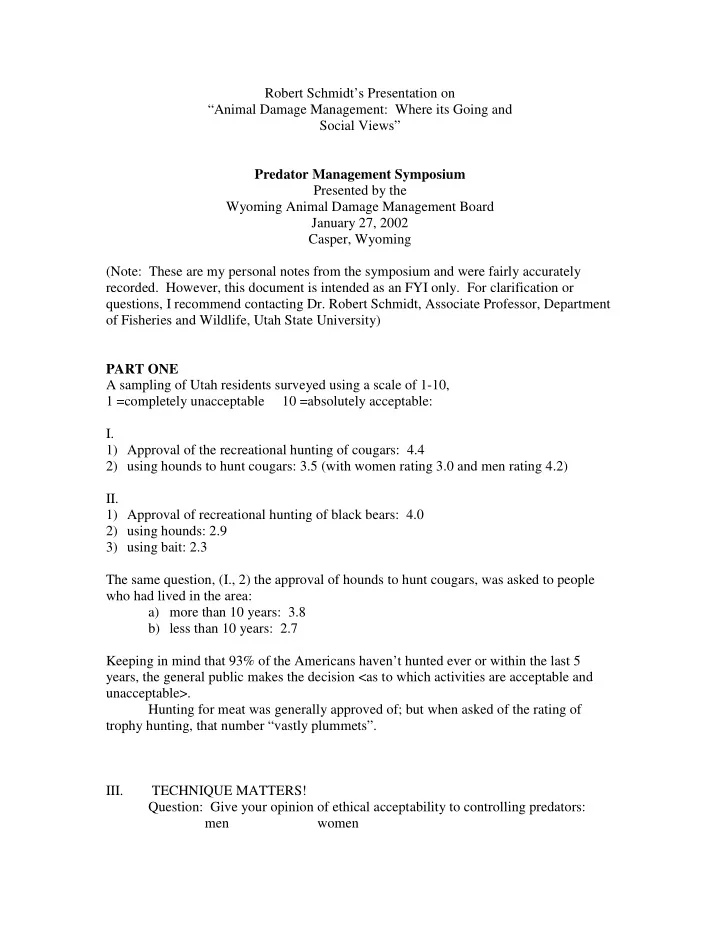

Robert Schmidt’s Presentation on “Animal Damage Management: Where its Going and Social Views” Predator Management Symposium Presented by the Wyoming Animal Damage Management Board January 27, 2002 Casper, Wyoming (Note: These are my personal notes from the symposium and were fairly accurately recorded. However, this document is intended as an FYI only. For clarification or questions, I recommend contacting Dr. Robert Schmidt, Associate Professor, Department of Fisheries and Wildlife, Utah State University) PART ONE A sampling of Utah residents surveyed using a scale of 1-10, 1 =completely unacceptable 10 =absolutely acceptable: I. 1) Approval of the recreational hunting of cougars: 4.4 2) using hounds to hunt cougars: 3.5 (with women rating 3.0 and men rating 4.2) II. 1) Approval of recreational hunting of black bears: 4.0 2) using hounds: 2.9 3) using bait: 2.3 The same question, (I., 2) the approval of hounds to hunt cougars, was asked to people who had lived in the area: a) more than 10 years: 3.8 b) less than 10 years: 2.7 Keeping in mind that 93% of the Americans haven’t hunted ever or within the last 5 years, the general public makes the decision <as to which activities are acceptable and unacceptable>. Hunting for meat was generally approved of; but when asked of the rating of trophy hunting, that number “vastly plummets”. III. TECHNIQUE MATTERS! Question: Give your opinion of ethical acceptability to controlling predators: men women
shooting 8.7 6.8 trapping 7.4 4.8 poison 3.4 1.8 IV. Is it ethical for humans to manage wildlife? 7.0 approval (survey conducted among wildlife biologists and managers—fairly low considering the group being surveyed) PART TWO V. In this survey, a stratified, random sampling was in place. 1=strongly disagree 5=approve 1) Acceptable to remove predators that prey on livestock? 3.7 2) Farmers have the right to control wildlife that are damaging their crops?: 3.6 3) Unacceptable to remove native predators that prey on threatened endangered species? 2.9 4) The careful use of poisons acceptable way to control wildlife populations?: 2.2 5) Acceptable to use big-small game hunting to control populations? 3.6 6) Predator control is unacceptable?: 2.4 7) Wildlife populations should not be managed (by ?): 2.4 8) Wildlife populations are a risk that comes with livestock production?: 3.5 9) Wildlife control is acceptable?: 3.5 Survey of Techniques: 1=strongly disagree with 5=approve of 1) Shooting from aircraft: 1.9 2) Fencing out: 4.0 3) Poisoned bait: 3.1 4) Scare devices: 4.0 5) Poisons for predators: 2.3 6) leghold traps: 1.7 7) human guards: 4.2 8) Live traps: 3.7 9) Foot snares: 1.9 10) Calling and shooting: 2.7 Schmidt’s interpretation of results: a) The response of the survey “ties humane-ness to fairness.” b) People react not just to WHAT is being done but also to HOW its being done. c) In general, the female segment of the sampling was less tolerant of predator control techniques and hunting than the male segment. d) Factors that influenced answers were dependent on: the length of the residence of the person polled, whether they lived in a rural or metropolitan area, whether they were fishermen, hunters or non-consumptive users. According to Schmidt’s findings, the trend would show that female, non- consumptive users who lived in an area such as Logan, UT for less than 10 years would
have the least amount of acceptability of predator control techniques The other end of the scale would show men who live in rural areas for more than 10 years and are hunters to have the most acceptable attitude toward predator control. However, the demographic trend is expected to continue with more people from metropolitan areas moving into rural communities, bringing their attitudes toward wildlife and predator control and management with them. e) Youngest category of those polled (ages 18-21) and the oldest (65+) were the most gung-ho about predator control. The middle shifted greatly away from the idea. f) The American public is sensitive g) 93% of Americans have never or haven’t hunted in the last five years
Recommend
More recommend